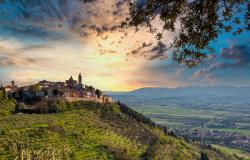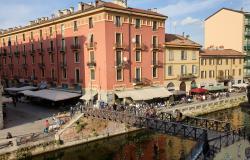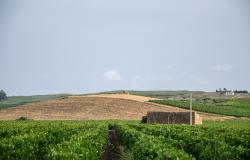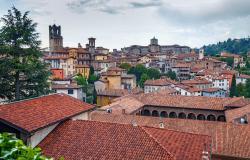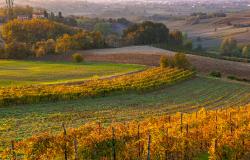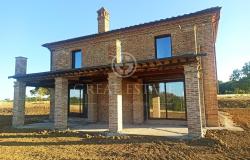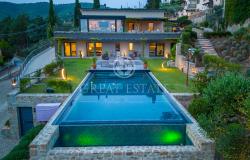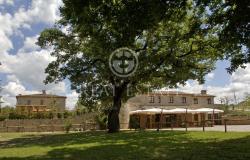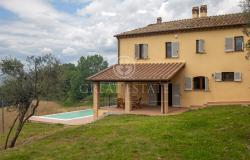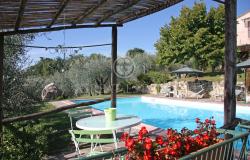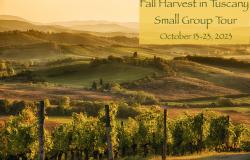When visiting Italy, you should always be ready for the unusual, the unexpected and for some continual surprises.
Norcia, which is tucked away in the remote, southeastern corner of Umbria is no exception, for it provides its own blend of the unexplained.
Noted for being the birthplace of Saint Benedict, the founder of Western Monasticism, its claim to fame today is that of culinary perfection. The locals here are renowned for their expert knife work, thus coining the term "Norcino", a butcher who, using ancient traditions, specialises in producing some of Italy’s finest prosciutto and salame from domestic pigs and wild boar.
But this picturesque, walled town of the upper Valnerina is also shrouded in mystery and legend.
Inner treasures
Situated in the Piano di Santa Scolastica and surrounded by the towering and legendary Sibillini mountains, Norcia is as ancient as it looks and its medieval aspect is still very much intact today, this being part of its quirky charm.

Nevertheless, I love exploring alleyways and mysterious-looking buildings, and Norcia has both in abundance. Once inside the walls, the centre was easily accessible, being only a few minutes’ walk from Porta Patino (or Palatino) on the northern edge of town to Piazza S. Benedetto where most of the action is.
Subsequent visits were more appealing and I was able to come across some interesting discoveries, although, sadly, much of Norcia’s inner treasures have been damaged or destroyed as a result of the numerous earthquakes that have devastated the town since 1328.
Exploring the centro storico
In the centre, don't miss the Palazzo Comunale, the Basilica di S.Benedetto, Santa Maria Argentea Cathedral, the Castellina, now housing the Museo Civico with its splendid collections, the Tempietto and the Teatro Civico.
Also impossible to resist are the magnificent norcinerie, the local delicatessens with their gastronomic delights (lentils, cheese, truffles and cured meats) and stuffed boar’s heads in full display for all to see. But what struck me in particular was the aromatic fragrance of burning firewood and cooked meat that pervaded the streets!

Religion and ritual
Norcia’s modest origins began in 1300 BC under the Sabines (an ancient tribe from Umbria), but later the town came to prominence under the Romans who developed it into a powerful municipality. After the collapse of the mighty Roman Empire the new ruling class included Barbarian invaders, the Lombards of Spoleto and the Catholic Church. During the Middle Ages, Christianity played a major role in controlling Norcia, the Valnerina and the Valcastoriana, and accusations of witchcraft and popular superstitions pervaded the Papal-controlled territories.
It is said that there was even a college for sorcery in Norcia during the Middle Ages, but the only thing standing witness to this necromantic setting today is the enigmatic Lago di Pilato which is located on Monte Vettore in the Sibillini mountains.

It is a place of pilgrimage. A place where many sorcerers from all over Europe once came to hold their strange rituals around its shores until Papal rulers put up a wall to prevent access to the lake. Some weird stones inscribed with occult symbols have apparently been found near the lake, suggesting perhaps that some truth and not just myth surrounds this very unusual place (sadly, no one knows where they are). Not only does the lake get its name from a remarkable legend concerning Pontius Pilate who is supposedly buried here, it is one of the most important visitor attractions in the entire Monti Sibillini National Park.
Local legend also has it that one of the ancient and wise priestesses with oracular powers lived near Norcia. The most famous of these, the Cumaean Sibyl from Campania, took refuge in a cave in the mountains above the town, which is perhaps why they are called the Monti Sibillini. Her magical kingdom seduced many intrepid visitors but those who came face to face with the Sibilla would discover that she was really a wicked temptress and once lured to her cave would eventually remain trapped there forever.

Black arts in Norcia
Mythical and legendary flirtation apart, there are some written accounts which seem to suggest that the black arts were actually practised in these parts. Pierre Bersuire told of macabre goings-on in Norcia. Antoine De La Salle wrote about his visit to the area in 1420, recording his findings in Le Paradis de la Reine Sybille. Fra' Bernadino Bonavoglia di Foligno wrote about strange rituals during the 15th century.
Enea Silvio Piccolomini (later Pope Pius II) knew of a location somewhere near Norcia where witchcraft was practised and taught. And we also learn a little more from Benvenuto Cellini who recorded in his autobiography that a Sicilian priest who liked to dabble in necromancy tried to persuade him to take part in a macabre ritual up in the Sibillini Montains in order to gain access to the riches of the world.
According to the priest, the locals were experienced in creating magic circles thus making Norcia a most suitable location for the black arts. By happy coincidence the name ‘Nursia’, which is said to be Etruscan in origin, is believed to have a magical connotation and most towns and villages in the area have inspired several tales that still associate Norcia and its environs with alchemy, witchcraft and sorcery to this very day.

Another kind of magic
To discover the hidden secrets of Norcia’s haunting landscape of myths and legends, you have to take the winding road that runs east of town and up to Forca Canapine. This extremely scenic route leads you to the eerie and desolate Piano Grande, a huge karstic basin that was once a glacial lake. Completely surrounded by the dark, craggy peaks and the barren slopes of the Sibillini mountains, the scenery here is unsurpassed. It is virtually inaccessible during winter and rather breathtaking.
The only magic you will find here is nature at its very best and the site is best seen during late spring when the entire plain is transformed into a techni-coloured sea of wild flowers. I am tempted to say that Norcia, the Piano Grande and the Sibillini mountains remind me of The Wizard of Oz, Escape to Witch Mountain, Harry Potter and the Philosopher’s Stone, and The Witches of Eastwick all rolled into one. But this fascinating corner of Italy goes much deeper than a flirtation with the hocus-pocus world of sorcery and witchcraft. It offers a fascinating insight into a seemingly timeless legacy of more than 3000 years of history.

